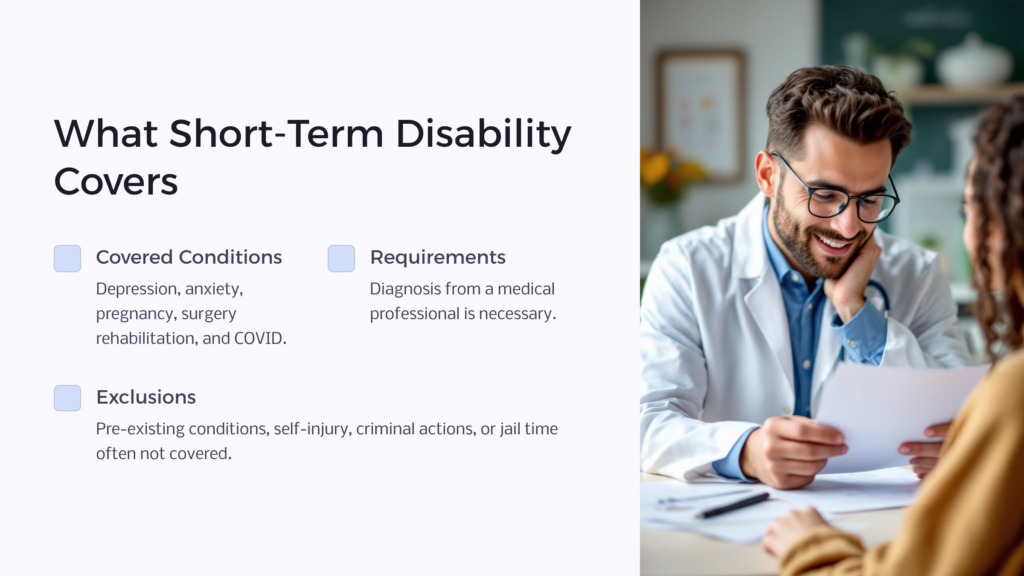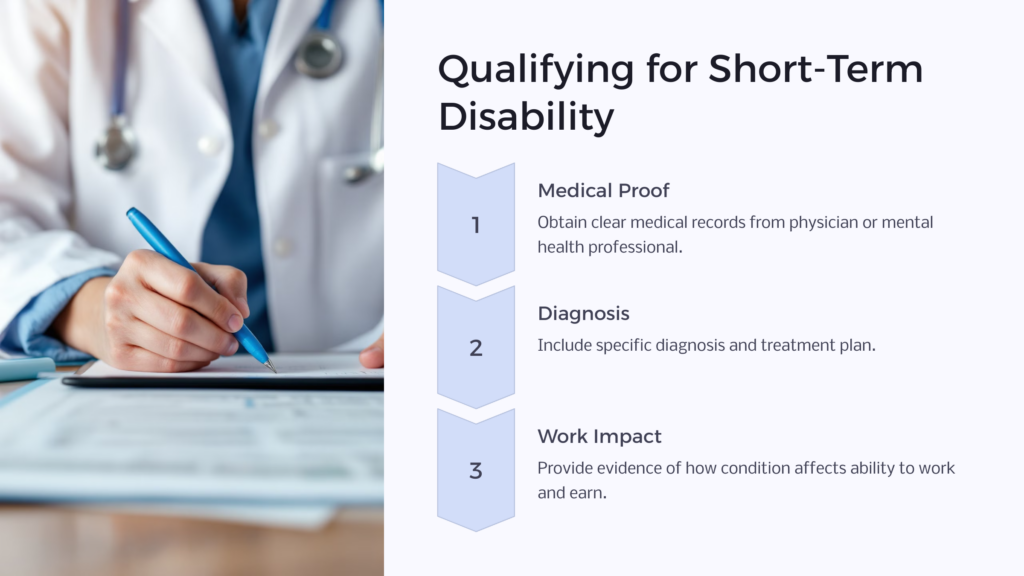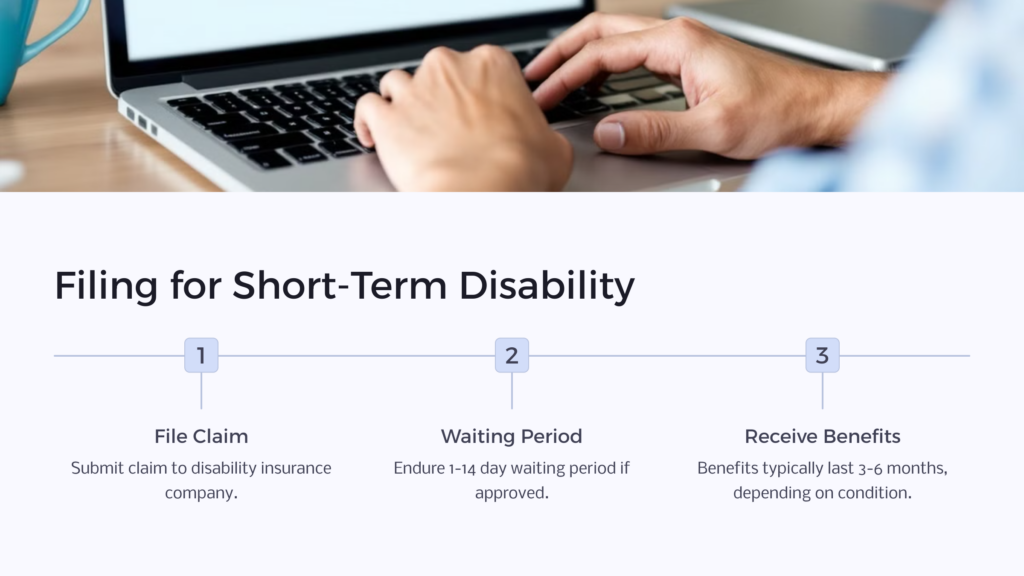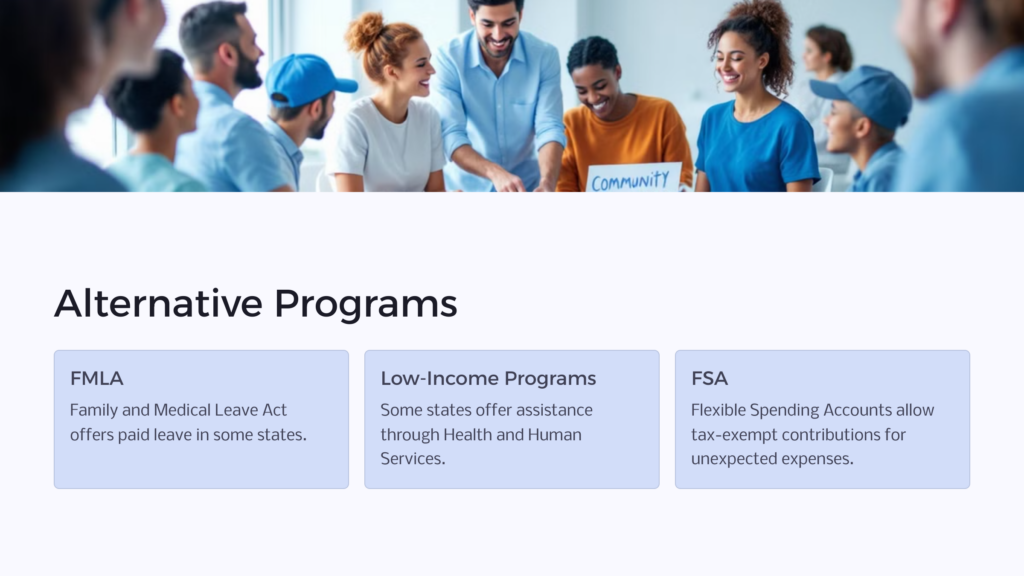Unlike long-term disability, short-term disability leave benefits are reserved for a few weeks or months away from work. STD benefits are typically used when a person is unable to work but is expected to be able to return from leave soon. The short-term disability plan offers temporary income replacement.
What is Short-Term Disability Insurance Coverage?

Short-term disability is insurance covering those with disabilities that are likely to improve. The program is designed to assist those who have to take a short period of time off from work due to an illness or injury.
Short-term disability may be available for the following conditions:
- Depression
- Anxiety
- Pregnancy
- Surgery rehabilitation
- COVID
Regardless of the medical condition, employees must have a diagnosis from a medical professional. Some conditions may be excluded from a short-term policy too, so it’s important to understand the rules of any plan you choose. For example, most short-term disability policies don’t cover leave from pre-existing conditions, self-injury, criminal actions, or jail time. The specific inclusions and exclusions may also vary between employers.
You may wonder what short-term disability is, especially if you have never heard of these programs. It’s important to note that short-term disability is not designed for missing one or two weeks for a bad case of the flu. Instead, it’s designed to help people deal with a debilitating diagnosis with a good chance of improvement. Short-term disability differs from workers’ compensation because the injury or illness is usually due to a cause unrelated to work.
A worker who receives disability benefits through workers’ compensation also isn’t eligible to receive disability benefits through short-term disability at the same time.
What Coverage is Available for Short-Term Disability?
Short-term disability insurance programs offer temporary leave while you recover from an illness or injury.

To qualify for short-term temporary disability insurance programs, you’ll need proof from your physician or mental health professional. You’ll need clear medical records that include the diagnosis, treatment plan, and evidence of how it affects your ability to work and earn a living.
How to File for Short-Term Disability Coverage Insurance

Short-term disability insurance offers relief to both the employee and their employer. The employees can file a claim with the disability insurance company to claim benefits. This can also help the employer cover the employee’s salary during their sick leave, even when they cannot work.
Not all employers offer short-term disability insurance plans. However, some states do require employers to carry short-term disability benefits. If you don’t have short-term disability insurance benefits available through your employer, you may be able to buy your own policy. Some employees choose to do this to protect themselves from temporary conditions or illnesses.
Once a short-term disability insurance claim is approved, employees may be subject to a short waiting period of 1-14 days. Traditional short-term disability benefits are available for anywhere between 3-6 months, depending on how long the condition takes to improve. This may vary among employees.
States With Short-Term Disability Benefits Programs
Currently, the only states with required short-term disability insurance programs are:
- California
- Hawaii
- New Jersey
- New York
- Rhode Island
Some other states not on this list do offer temporary disability programs in the form of low-income programs. Many U.S. states also have the Family and Medical Leave Act (FMLA), which offers paid leave for various family needs.

This paid family medical leave program also covers the employee’s family’s medical or mental health conditions. California, Colorado, Connecticut, Massachusetts, New Jersey, New York, Oregon, Rhode Island, and Washington all have FMLA programs. FMLA programs, unlike short-term disability, are usually available to all employees in that state.
Some states may also offer assistance in the form of low-income programs at the Health and Human Services department. Some employers may also have flexible spending accounts (FSA), which allow employees to contribute tax-exempt funds for unexpected expenses.
Short-Term Vs. Long-Term Disability
Short-term and long-term disability benefits help cover costs when employees are unable to work. However, there are a few key differences between the two types of programs, including:
- Length of plan benefits: Whereas long-term disability benefits last anywhere between 2-10 years (with some for life), short-term benefits are for a leave period of between 3-12 months.
- Benefits amounts: Long-term disability benefits allow for spending between 60-80% of lost wages. Short-term benefits are limited to between 40-70% of lost wages.
- Elimination period: The elimination period, which refers to the length of time you must be injured or ill for benefits to kick in, also differs between each program. The elimination period for long-term disability benefits is 90 days, whereas the average for short-term plans is 14 days.
There are also some similarities between short and long-term plans. Both short and long-term disability plans are usually available through private insurance policies or employer-sponsored plans. Employees typically pay anywhere between 1-3% of their pre-tax salary to enroll in these disability plans.
Whereas short-term disability plans are for temporary injuries or conditions, long-term disability plans cover conditions unlikely to improve soon. Both can cover severe conditions, and the distinction is more in the leave time or the length of time a person cannot work.
Mental health and short-term disability benefits are also possible, whereas long-term disability programs don’t typically cover most psychological disorders. With short-term benefits, you may be able to receive disability benefits and temporary leave from work for conditions like anxiety or depression.
How We Can Help With Your Short-Term Disability Case
Proving the inability to work with a short-term disability can be even more difficult than with a long-term condition. A lot of short-term claims are denied on the first filing. We can help you take advantage of your right to appeal, helping you get the funds you need to focus on your recovery.
Our team also helps employees review and choose the best short-term disability plan for their unique needs. If you don’t have short-term disability benefits available through your employer, we can also help you review other options. Only a few U.S. states have short-term state disability programs.
Make sure you have the coverage you need, whether long- or short-term. If you have a condition that qualifies for long-term disability benefits, we can also help you explore programs like Supplemental Security Income (SSI) and Social Security Disability Insurance (SSDI).
Contact one of our friendly representatives today to learn how we can help you protect your finances and prepare for the future.
 Benefits.com Advisors
Benefits.com Advisors
With expertise spanning local, state, and federal benefit programs, our team is dedicated to guiding individuals towards the perfect program tailored to their unique circumstances.
Rise to the top with Peak Benefits!
Join our Peak Benefits Newsletter for the latest news, resources, and offers on all things government benefits.




















